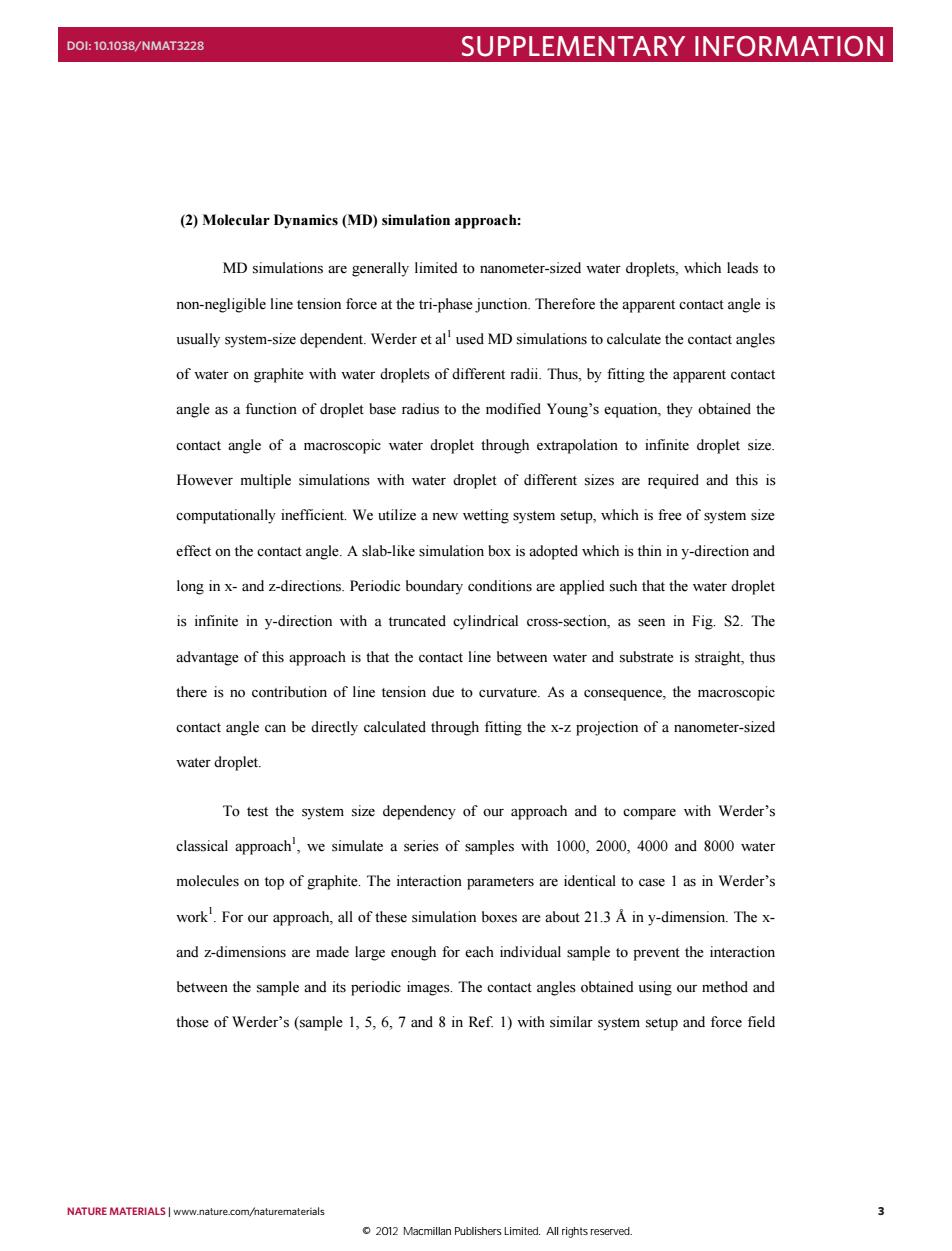正在加载图片...

DOE:10.1038/NMAT3228 SUPPLEMENTARY INFORMATION (2)Molecular Dynamics(MD)simulation approach: MD simulations are generally limited to nanometer-sized water droplets,which leads to non-negligible line tension force at the tri-phase junction.Therefore the apparent contact angle is usually system-size dependent.Werder et al'used MD simulations to calculate the contact angles of water on graphite with water droplets of different radii.Thus,by fitting the apparent contact angle as a function of droplet base radius to the modified Young's equation,they obtained the contact angle of a macroscopic water droplet through extrapolation to infinite droplet size. However multiple simulations with water droplet of different sizes are required and this is computationally inefficient.We utilize a new wetting system setup,which is free of system size effect on the contact angle.A slab-like simulation box is adopted which is thin in y-direction and long in x-and z-directions.Periodic boundary conditions are applied such that the water droplet is infinite in y-direction with a truncated cylindrical cross-section,as seen in Fig.S2.The advantage of this approach is that the contact line between water and substrate is straight,thus there is no contribution of line tension due to curvature.As a consequence,the macroscopic contact angle can be directly calculated through fitting the x-z projection of a nanometer-sized water droplet. To test the system size dependency of our approach and to compare with Werder's classical approach',we simulate a series of samples with 1000,2000,4000 and 8000 water molecules on top of graphite.The interaction parameters are identical to case I as in Werder's work'.For our approach,all of these simulation boxes are about 21.3 A in y-dimension.The x- and z-dimensions are made large enough for each individual sample to prevent the interaction between the sample and its periodic images.The contact angles obtained using our method and those of Werder's(sample 1,5,6.7 and 8 in Ref.1)with similar system setup and force field NATURE MATERIALS www.nature.com/naturematerials 2012 Macmillan Publishers Limited.All rights reserved.(2) Molecular Dynamics (MD) simulation approach: MD simulations are generally limited to nanometer-sized water droplets, which leads to non-negligible line tension force at the tri-phase junction. Therefore the apparent contact angle is usually system-size dependent. Werder et al1 used MD simulations to calculate the contact angles of water on graphite with water droplets of different radii. Thus, by fitting the apparent contact angle as a function of droplet base radius to the modified Young’s equation, they obtained the contact angle of a macroscopic water droplet through extrapolation to infinite droplet size. However multiple simulations with water droplet of different sizes are required and this is computationally inefficient. We utilize a new wetting system setup, which is free of system size effect on the contact angle. A slab-like simulation box is adopted which is thin in y-direction and long in x- and z-directions. Periodic boundary conditions are applied such that the water droplet is infinite in y-direction with a truncated cylindrical cross-section, as seen in Fig. S2. The advantage of this approach is that the contact line between water and substrate is straight, thus there is no contribution of line tension due to curvature. As a consequence, the macroscopic contact angle can be directly calculated through fitting the x-z projection of a nanometer-sized water droplet. To test the system size dependency of our approach and to compare with Werder’s classical approach1 , we simulate a series of samples with 1000, 2000, 4000 and 8000 water molecules on top of graphite. The interaction parameters are identical to case 1 as in Werder’s work1 . For our approach, all of these simulation boxes are about 21.3 Å in y-dimension. The xand z-dimensions are made large enough for each individual sample to prevent the interaction between the sample and its periodic images. The contact angles obtained using our method and those of Werder’s (sample 1, 5, 6, 7 and 8 in Ref. 1) with similar system setup and force field NATURE MATERIALS | www.nature.com/naturematerials 3 DOI: 10.1038/NMAT3228 SUPPLEMENTARY INFORMATION © 2012 Macmillan Publishers Limited. All rights reserved